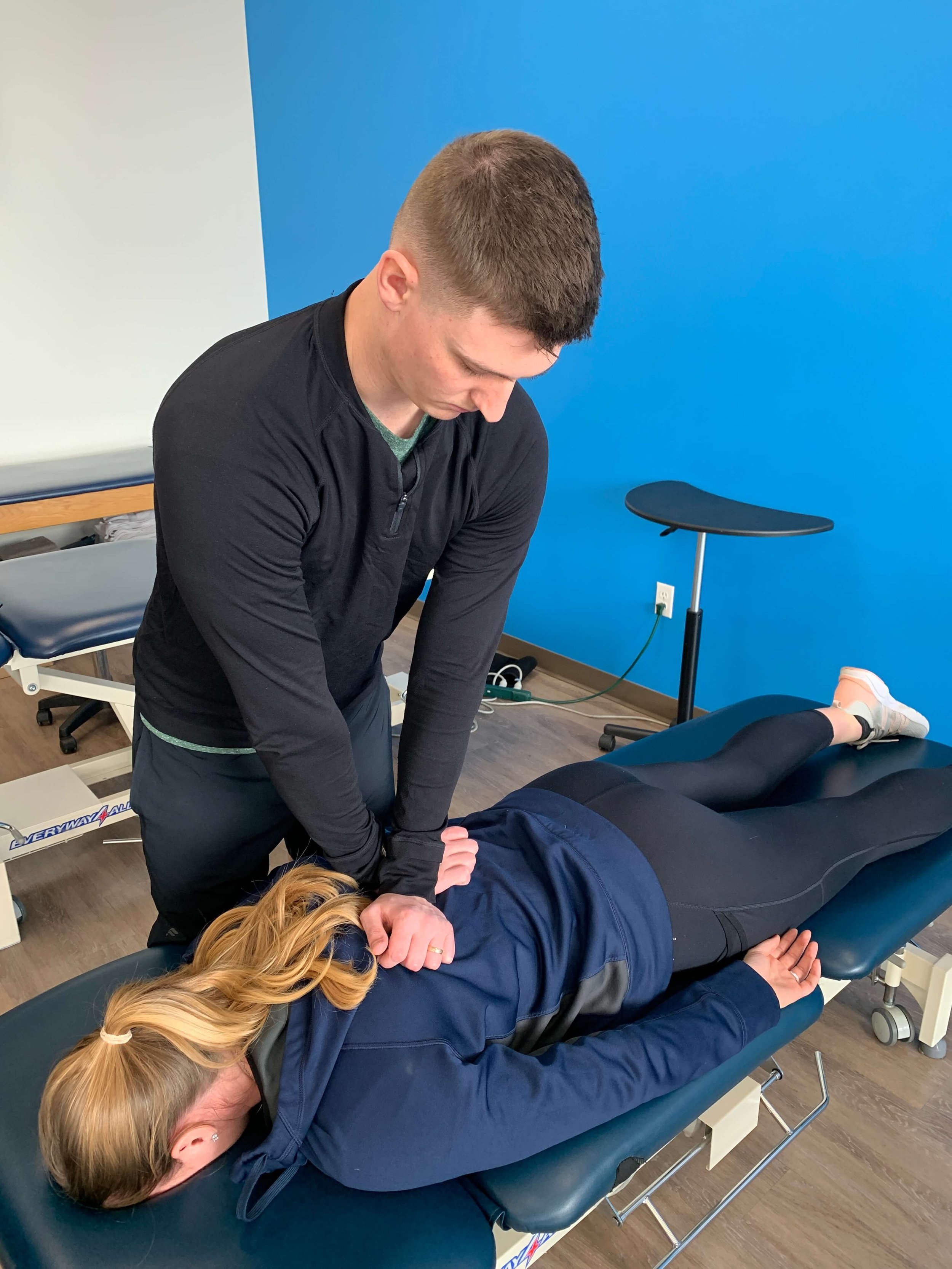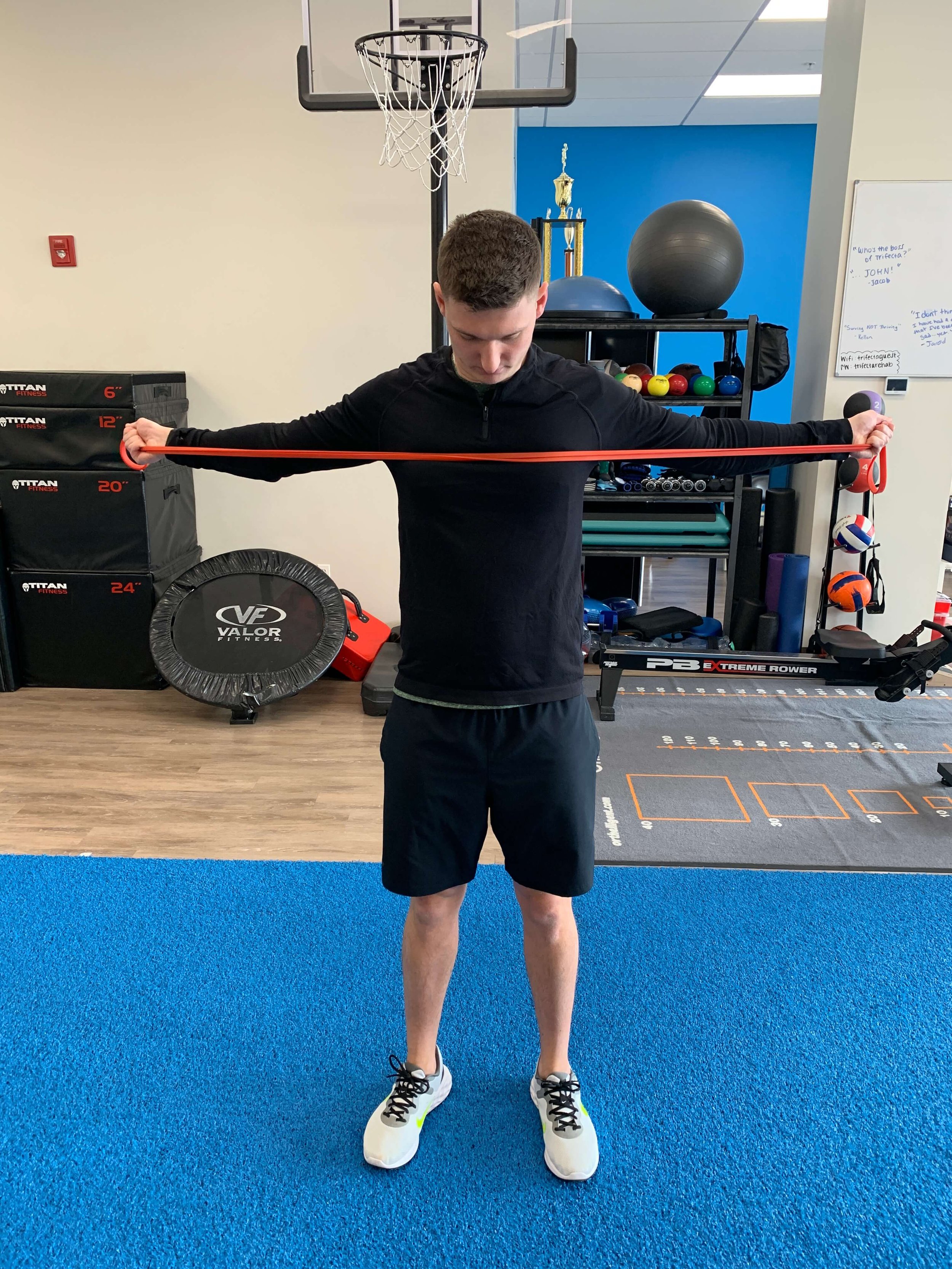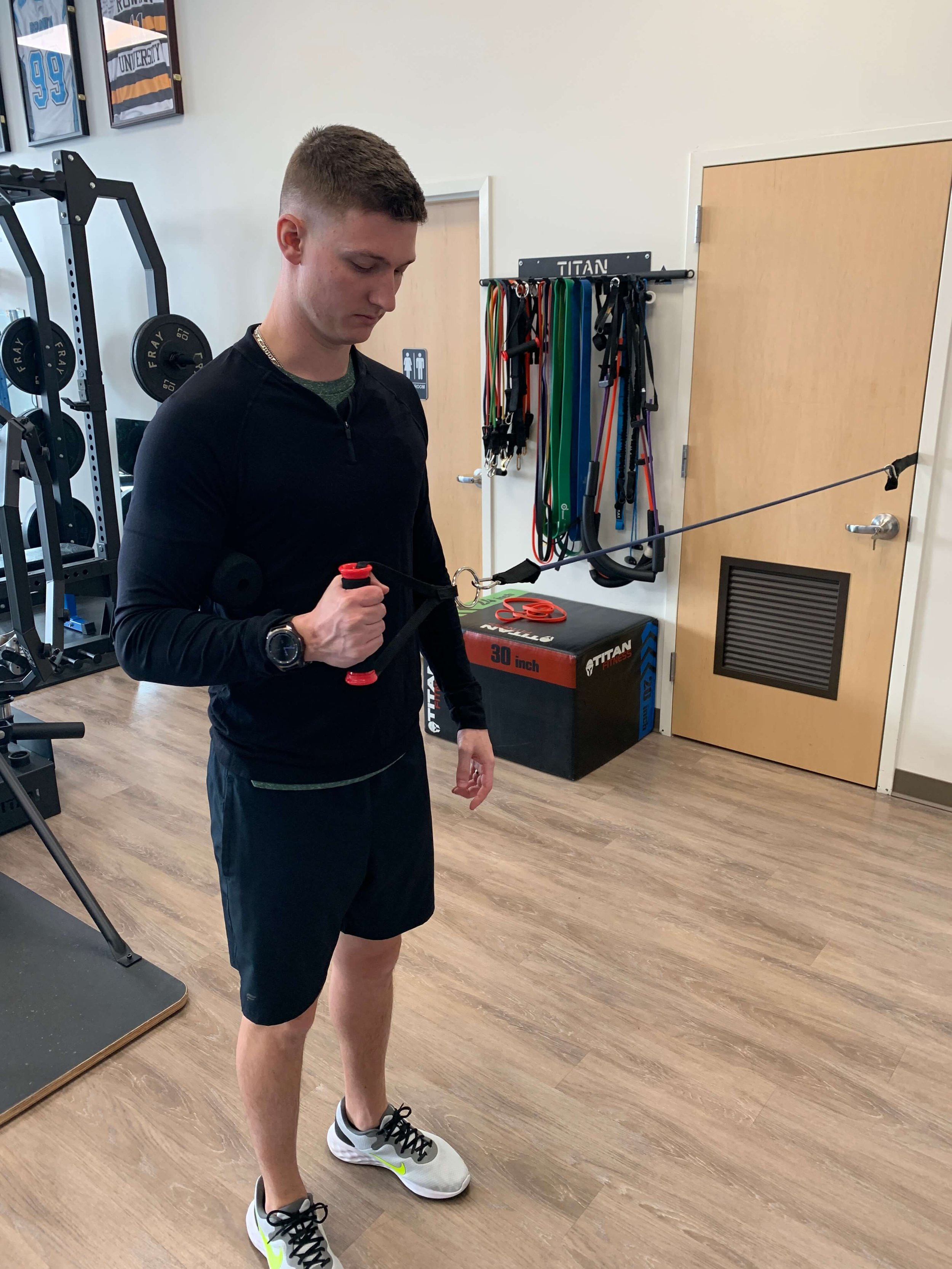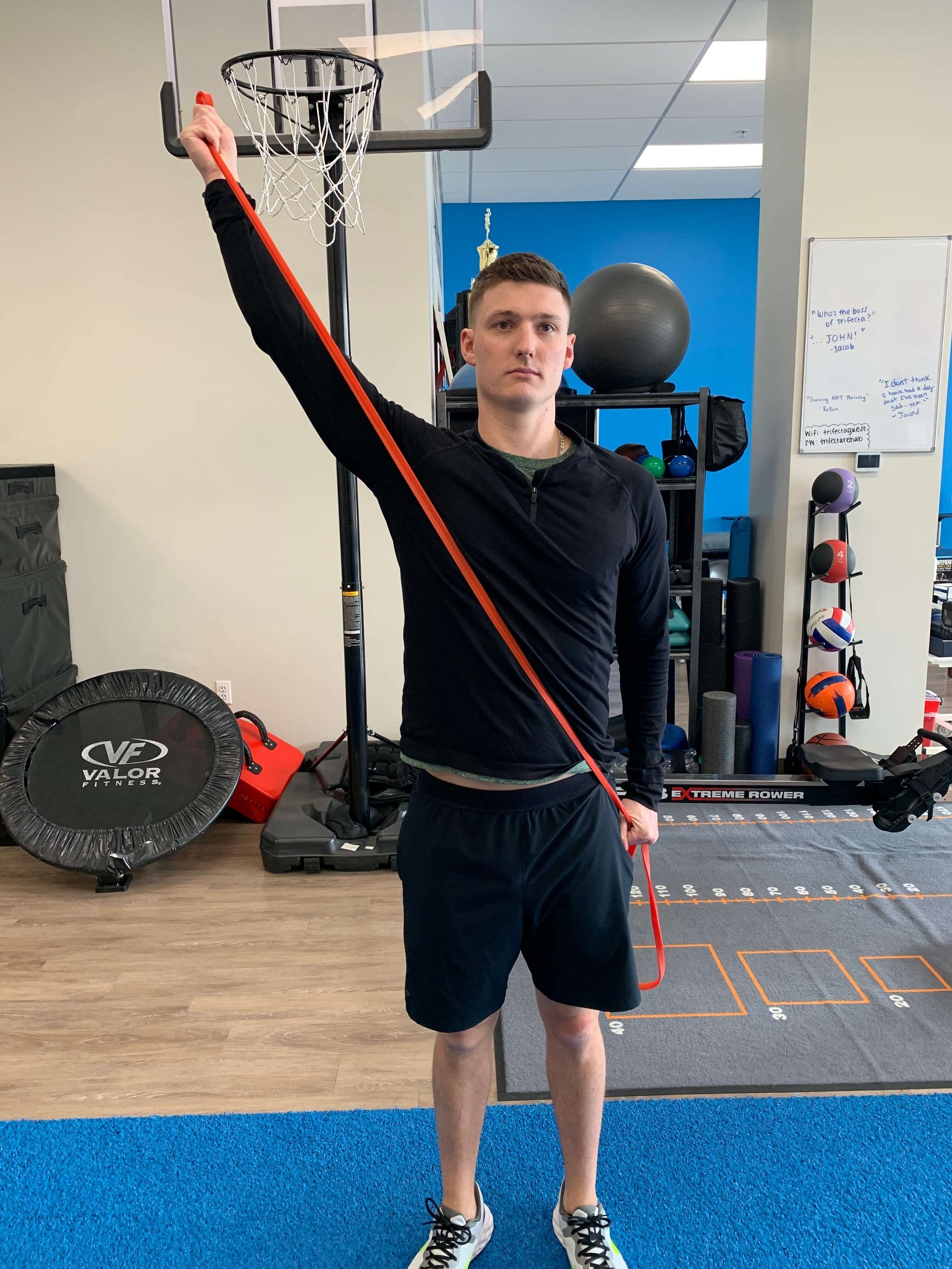Thoracic Outlet Syndrome
Thoracic Outlet Syndrome (TOS) is an uncommon diagnosis of shoulder pain that is prevalent in sports that requires repetitive overhead movements such as baseball, softball, swimming, tennis, volleyball, and even olympic style lifting.
TOS has a variety of symptoms that are determined by the compression of one or more of the structures within the “Thoracic Outlet”: brachial plexus, subclavian artery, or the subclavian vein.
These areas are at a higher risk of compression with the arm raised overhead and reaching behind the body, similarly to throwing a ball.
There are three types of TOS that correspond to the structures that are being compressed; nTOS, vTOS, and aTOS.
nTOS (Neurogenic)
nTOS is caused by the compression of the brachial plexus, most commonly as it exits the scalene triangle located on the side of the neck. Common symptoms associated with nTOS are pain in the arm or neck that may radiate along the inside of the arm, numbness or tingling of the 4th and 5th finger, weakness of the hand or loss in dexterity, and a loss of pitch control. Exacerbating factors of nTOS could be due to a history of neck trauma and stress from repetitive overhead movements.
vTOS (Venous)
vTOS is caused by the compression of the subclavian vein most commonly as it exits the costoclavicular space just below the collar bone. vTOS is sometimes referred to as Paget-Schroetter syndrome. Common symptoms associated with vTOS are arm swelling with repetitive overhead movements, pain in the arm, cyanosis of the forearm or hand and a feeling of heaviness of the arm. Exacerbating factors of vTOS are a history of heavy overhead lifting and can present as swelling of the arm after a workout.
aTOS (Arterial)
aTOS is caused by the compression of the subclavian artery most commonly as it exits the costoclavicular space just below the collar bone. Common symptoms associated with aTOS are pain and weakness of the radial puls with large amplitude movements, pale coloration of the arm, weakness and fatigue of the arm. aTOS is the rarest, but most dangerous out of the three due to the lack of bloodflow and oxygen being dispersed to the arm.
Treatments
Common treatments to reduce the symptoms of TOS include: Physical Therapy, first rib resection and anterior scalectomy (FRRS), botox, and thrombolysis.
First Rib Resection and Anterior Scalectomy (FRRS)
FRRS is a decompression surgery that removes part of the first rib and anterior scalene muscle to make space for the compressed structures. This surgery provides a relief of symptoms and improves function of the individual. However, Chandra et al, completed a study that followed 27 overhead athletes who had nTOS; 18 went through the FRRS decompression and 9 went through physical therapy treatment only. Although athletes who received the decompression surgery had immediate increase in functional use, those who had PT only had a reduction of symptoms and also increased functional use of their arm. 22/27 athletes were able to return to full participation either to or above their previous level of play.
Botox
Botox injections are used to relax the muscles in the neck that may be compressing on the nerves and blood vessels in an attempt to decrease symptoms in the hand or arm. In a double-blind randomized control trial study, they determined that the use of Botox injections did not show any significant improvement to those who did not receive the injections.
Although there is no one protocol for treating someone who presents with TOS, there are interventions available to us that can help modulate pain and improve impairments the patient may present with. Based on recent case studies, an athlete who presents with TOS also present with tight neck and upper back muscles as well as a decrease in upper back extension, which limits how high someone can raise their arm overhead. This leads to compensatory movements which increases the tightness in those muscles. Positive results have been recorded with treating the back to more distal regions such as the arm.
Proper layering of a treatment session is vital of any physical therapy session, but especially important when a diagnosis has multiple factors that may be contributing to the impairments. Layering a session with mobility interventions and exercises prior to strengthening exercises will help reinforce utilizing full range of motion during movements.
Physical therapists have several tools available to increase thoracic extension mobility, including thoracic mobilizations on the table and having the patient perform active thoracic extension over a chair or foam roller.
After addressing mobility of the spine, exercises like scapular retractions provide the patient with motor recruitment of muscles in the back to assist with keeping an upright posture and decrease rounded shoulders compressing on the structures in the front of the shoulder.
A physical therapist can utilize the thrower’s ten program to specify exercises that relate to overhead athletes. This progression of exercises provides a template of strengthening the shoulder girdle to provide a strong foundation for their return to sport.
Treating TOS prior to receiving the decompression surgery seems to be the best option for those who are diagnosed with nTOS. This will give the individual an opportunity to reduce their symptoms through non-invasive means and reduce their medical costs, especially due to the high likelihood of their referral to physical therapy after the surgery. For individuals diagnosed with vTOS or aTOS the surgical option may be more beneficial due to the anatomical variances that may be the cause of their symptoms.
It is important for medical professionals such as physical therapists, surgeons, and primary care doctors to communicate and use their clinical judgements to determine the best course of action for treating an individual with TOS. An earlier detection of symptoms, coupled with early intervention will lead to a quicker resolution of symptoms, an improvement in quality of life and potential return to sport at their previous level of competition.
By: Spencer Ray SPT
References
Troyer W, Gardner JE, Bowers RL. Neurogenic thoracic outlet syndrome in the overhead and throwing athlete: A narrative review [published online ahead of print, 2022 Apr 10]. PM R. 2022;10.1002/pmrj.12816. doi:10.1002/pmrj.12816
Li N, Dierks G, Vervaeke HE, et al. Thoracic Outlet Syndrome: A Narrative Review. J Clin Med. 2021;10(5):962. Published 2021 Mar 1. doi:10.3390/jcm10050962
Chandra V, Little C, Lee JT. Thoracic outlet syndrome in high-performance athletes. J Vasc Surg. 2014;60(4):1012-1018. doi:10.1016/j.jvs.2014.04.013
Colbert L, Harrison C, Nuelle C. Rehabilitation in Overhead Athletes With Thoracic Outlet Syndrome. Arthrosc Sports Med Rehabil. 2022;4(1):e181-e188. Published 2022 Jan 28. doi:10.1016/j.asmr.2021.11.007
Wilk KE, Arrigo CA, Hooks TR, Andrews JR. Rehabilitation of the Overhead Throwing Athlete: There Is More to It Than Just External Rotation/Internal Rotation Strengthening. PM R. 2016;8(3 Suppl):S78-S90. doi:10.1016/j.pmrj.2015.12.005







